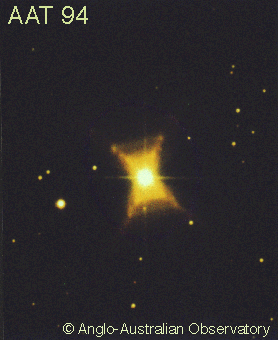
ResearchDiffuse Interstellar Absorption BandsThe longest standing problem in astronomical spectroscopy is the assignment of the unidentified diffuse interstellar absorption bands which are observed along lines of sight towards stars that are reddened by interstellar dust. There has been controversy for many years as to whether the bands arise in free gas-phase molecules or interstellar grains. Identification of the carriers is important as this would undoubtedly reveal much about the chemical composition and physical conditions of the interstellar medium (ISM), possibly with far-reaching implications. It is thought that the diffuse band carriers are rich in carbon so it is possible that the solution may carry clues concerning the production of molecules necessary to sustain life.The most important results to date are the demonstration that the wavelengths of prominent optical emission bands from the peculiar Red Rectangle nebula (AAT image below) fall very close to those of a sub-set of the diffuse interstellar absorption bands - and so are very likely due to the same carriers, and secondly, that some of the narrower diffuse absorption bands, when observed at extremely high resolution, exhibit fine structure. Both results provide strong support for an origin in free gas phase molecules. Some of this work and on binary systems described below is carried out in collaboration with with Dr Steve Fossey (UCL). Unidentified Infrared Emission BandsWe have made spatially and wavelength-resolved observations of the 'PAH' 3.3 micron and mid-IR infrared emission bands from the Red Rectangle. Among the objectives is to seek correlations, or otherwise, between the band intensities and profiles and those of the unidentified optical emission bands, and to unravel the precise chemical form of the carriers. We collaborate with Dr Tom Kerr (UKIRT) and Dr. In-Ok Song (Kyung Hee University, Korea) on this project.Small-Scale Structure of the ISMUsing UCLES on the AAT we have recently obtained extremely high signal-to-noise spectra of diffuse bands towards binary stars. We have found surprisingly large variations in diffuse band strengths for lines of sight separated by the order of a few hundred au. As the band strengths are well correlated with reddening, this provides a very valuable tracer of dust distribution on this small distance scale.Molecules in Cool Stellar and Circumstellar MediaIn collaboration with Tom Lloyd Evans, we have accomplished the first vibrational band assignments of the Merrill-Sanford bands of SiC2 recorded in absorption in some carbon stars and in emission from cool circumstellar gas. This allows determination of molecular vibrational and rotational temperatures and gives a new probe of chemical and physical conditions in carbon stars. Bands of TiO have been recorded and are being analysed and modelled using a radiative transfer code.Dust and molecules in the early UniverseStudies of diffuse interstellar band (DIB) absorption in external galaxies are limited to studies in the Magellanic Clouds and a few other galaxies. We have just started a search for diffuse interstellar bands at cosmological distances. This is being undertaken using the light of a background quasar passing through an intervening red-shifted galaxy. This is of particular interest because the DIB carriers are generally thought to be large organic molecules and hence trace the presence of precursors for life. |
|


